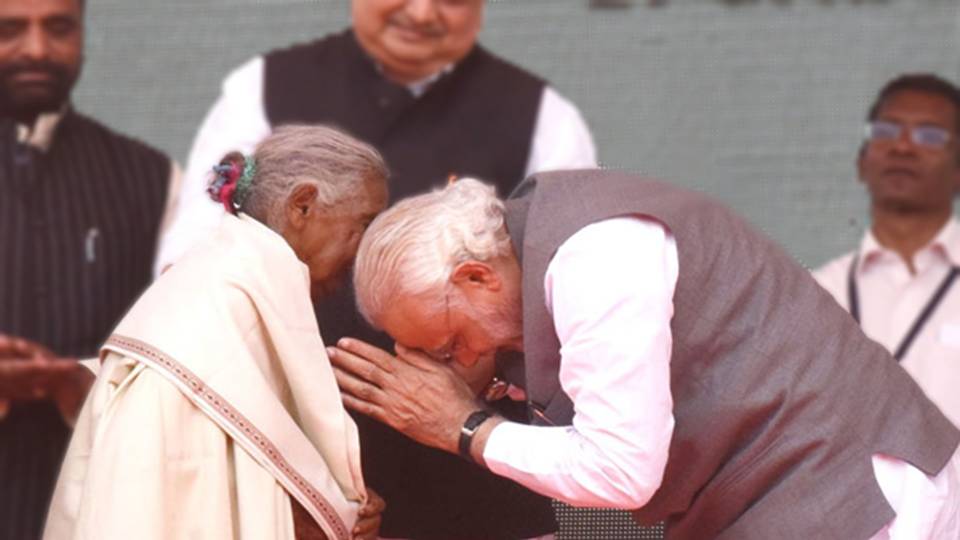Development of society lies in the government’s capacity to implement and realise the intended goals on ground level. It involves an efficient administration comprising the mechanism, process and institution through which citizens articulate their interest, exercise their legal rights and meet their obligations. Considering all these parameters of development, if we analyse PM Modi’s last-mile-administration model, then it can be said that he has turned the vision policy into reality and set development goals in motion.
Bottom-up Approach
In a recently concluded National Conference of Chief Secretaries, the officials have lauded the PM’s bottom-up approach in policy initiative. Getting first hand information from the ground, making & implementing policies in collaborative and consultative ways has developed the feelings of ‘Team India’ among the officials.
His consistent direct interactions with all India civil servants, panchayat leaders, doctors, teachers and intended beneficiaries give him the first hand experience of both administrations and public. The results of this ground experience also reflect in his policy implementation technique and solutions there off.
Read More: Mission Karmayogi – A new programme by PM Modi to kick out the Babudom from Babus
Instrument of Governance
Using digital technology, PM Modi has virtually reached every panchayat office of the country and interacted with panchayat leaders. Learning the grass root problems directly from village level, he has completely transformed the development model in villages. The launch of Swachh Bharat Scheme under which toilets in every home with government funding proved to be instrumental in helping the government to fight preventable diseases. Further, incentivising the panchayats at local level for their Swachh Bharat Abhiyan proved to be the game changer in policy implementations.
Another ambitious programme launched by the Hon’ble PM in January 2018, the Aspirational Districts programme aims to quickly and effectively transform 112 most under-developed districts across the country. The broad contours of the programme are Convergence (of Central & State Schemes), Collaboration (of Central, State level ‘Prabhari’ Officers & District Collectors), and Competition among districts through monthly ranking; all driven by a mass movement.
Former PM Rajiv Gandhi had once said that for every rupee targeted towards welfare of the people only 15 paise reaches the intended beneficiary. Fighting with the same problem Prime Minister Modi launched the ground level financial inclusion program under which Jan Dhan, Aadhaar and Mobile (JAM trinity) was connected to give seamless benefit to intended beneficiary plugging the leakages in the system. The result of this linkage was that the government was able to achieve a 100% direct benefit target (DBT) to its beneficiaries.
Read More: ‘You are not taking courageous decisions,’ PM Modi gives a piece of his mind to IAS officers
Transforming the administration
Programmes like Mission ‘Karmayogi’ which envisages to prepare Indian civil servants for the future by making them more creative, constructive, imaginative, innovative, proactive, professional, progressive, energetic, enabling, transparent and technology-enabled has helped to enhance the capacity building of bureaucracy and has changed the mindset of civil servants from earlier administrator to facilitator of growth.
Moreover, he has been overseeing monthly meetings named as PRAGATI. This brings all the highest officials of central government, state government and other officials on one table to improve
Key socio-economic developments like health, nutrition, education, agriculture, water resources, financial inclusion, skill development and infrastructure are the foundational pillars of a developed society. Without providing these basic amenities to its people no government can claim to succeed in its governance.
Contrary to what he has been shown in the media narratives, PM Modi is the most decentralised leader in India. He has been a vocal supporter of the three tier system of governance. Evidently he was the one who brought the three-tier decentralised system in the Union territory of Jammu and Kashmir. Similarly, he has tried to personally connect to the remotest area possible and have a detailed real time ground analysis of their grievance, efficiency of delivery of schemes and policies.
So over the years, PM Modi’s focus has been on bringing the lowest strata of society in the target beneficiaries list of the set parameters. With the bottom – up approach, the government has directly reached to the people. With the help of massive digital penetration in the country, PM has truly worked on the democratic principles of unstoppable growth and his last-mile-administration model follows the real spirit of welfare democratic government.
Support TFI:
Support us to strengthen the ‘Right’ ideology of cultural nationalism by purchasing the best quality garments from TFI-STORE.COM
